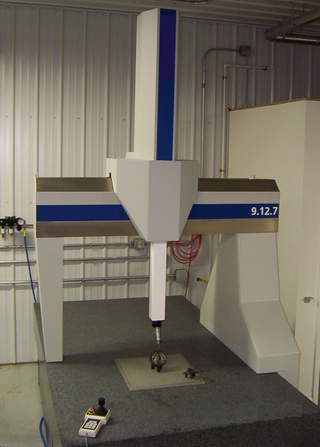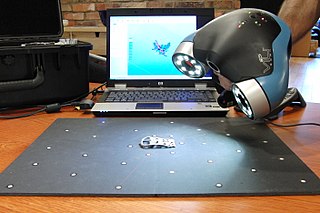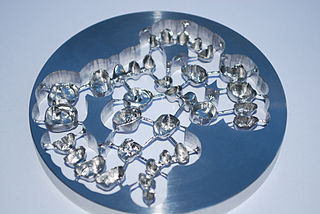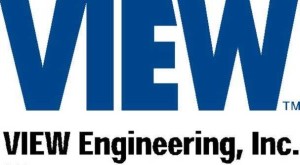Related Research Articles

Computer-aided design (CAD) is the use of computers to aid in the creation, modification, analysis, or optimization of a design. This software is used to increase the productivity of the designer, improve the quality of design, improve communications through documentation, and to create a database for manufacturing. Designs made through CAD software help protect products and inventions when used in patent applications. CAD output is often in the form of electronic files for print, machining, or other manufacturing operations. The terms computer-aided drafting (CAD) and computer-aided design and drafting (CADD) are also used.

A point cloud is a discrete set of data points in space. The points may represent a 3D shape or object. Each point position has its set of Cartesian coordinates. Point clouds are generally produced by 3D scanners or by photogrammetry software, which measure many points on the external surfaces of objects around them. As the output of 3D scanning processes, point clouds are used for many purposes, including to create 3D computer-aided design (CAD) models for manufactured parts, for metrology and quality inspection, and for a multitude of visualizing, animating, rendering, and mass customization applications.

An image scanner—often abbreviated to just scanner—is a device that optically scans images, printed text, handwriting or an object and converts it to a digital image. Commonly used in offices are variations of the desktop flatbed scanner where the document is placed on a glass window for scanning. Hand-held scanners, where the device is moved by hand, have evolved from text scanning "wands" to 3D scanners used for industrial design, reverse engineering, test and measurement, orthotics, gaming and other applications. Mechanically driven scanners that move the document are typically used for large-format documents, where a flatbed design would be impractical.

A coordinate measuring machine (CMM) is a device that measures the geometry of physical objects by sensing discrete points on the surface of the object with a probe. Various types of probes are used in CMMs, the most common being mechanical and laser sensors, though optical and white light sensor do exist. Depending on the machine, the probe position may be manually controlled by an operator or it may be computer controlled. CMMs typically specify a probe's position in terms of its displacement from a reference position in a three-dimensional Cartesian coordinate system. In addition to moving the probe along the X, Y, and Z axes, many machines also allow the probe angle to be controlled to allow measurement of surfaces that would otherwise be unreachable.

3D scanning is the process of analyzing a real-world object or environment to collect three dimensional data of its shape and possibly its appearance. The collected data can then be used to construct digital 3D models.
DSSP stands for digital shape sampling and processing. It is an alternative and often preferred way of describing "reverse engineering" software and hardware. The term originated in a 2005 Society of Manufacturing Engineers' "Blue Book" on the topic, which referenced numerous suppliers of both scanning hardware and processing software.
ASME Y14.41 is a standard published by American Society of Mechanical Engineers (ASME) which establishes requirements and reference documents applicable to the preparation and revision of digital product definition data, which pertains to CAD software and those who use CAD software to create the product definition within the 3D model. ASME issued the first version of this industrial standard on Aug 15, 2003 as ASME Y14.41-2003. It was immediately adopted by several industrial organizations, as well as the Department of Defense (DOD). The latest revision of ASME Y14.41 was issued on Jan 23, 2019 as ASME Y14.41-2019.
InspecVision Ltd. is a UK engineering company based in Mallusk, Northern Ireland, established in 2003. It is a manufacturing company that produces computer vision inspection systems. The company is one of several local companies created as spinoffs or inspired by research conducted at the Queen's University of Belfast.
Dimensional metrology, also known as industrial metrology, is the application of metrology for quantifying the physical size, form (shape), characteristics, and relational distance from any given feature.

CAD/CAM dentistry is a field of dentistry and prosthodontics using CAD/CAM to improve the design and creation of dental restorations, especially dental prostheses, including crowns, crown lays, veneers, inlays and onlays, fixed dental prostheses (bridges), dental implant supported restorations, dentures, and orthodontic appliances. CAD/CAM technology allows the delivery of a well-fitting, aesthetic, and a durable prostheses for the patient. CAD/CAM complements earlier technologies used for these purposes by any combination of increasing the speed of design and creation; increasing the convenience or simplicity of the design, creation, and insertion processes; and making possible restorations and appliances that otherwise would have been infeasible. Other goals include reducing unit cost and making affordable restorations and appliances that otherwise would have been prohibitively expensive. However, to date, chairside CAD/CAM often involves extra time on the part of the dentist, and the fee is often at least two times higher than for conventional restorative treatments using lab services.

Rapid prototyping is a group of techniques used to quickly fabricate a scale model of a physical part or assembly using three-dimensional computer aided design (CAD) data. Construction of the part or assembly is usually done using 3D printing or "additive layer manufacturing" technology.
Digital modeling and fabrication is a design and production process that combines 3D modeling or computing-aided design (CAD) with additive and subtractive manufacturing. Additive manufacturing is also known as 3D printing, while subtractive manufacturing may also be referred to as machining, and many other technologies can be exploited to physically produce the designed objects.
A structured-light 3D scanner is a 3D scanning device for measuring the three-dimensional shape of an object using projected light patterns and a camera system.
Laser Design Inc. is a company headquartered in Minneapolis, MN that designs, manufactures, and sells 3D laser scanners, used to digitally capture the shape of physical objects such as free-form surfaces and geometries.

Synopsys Simpleware ScanIP is a 3D image processing and model generation software program developed by Synopsys Inc. to visualise, analyse, quantify, segment and export 3D image data from magnetic resonance imaging (MRI), computed tomography (CT), microtomography and other modalities for computer-aided design (CAD), finite element analysis (FEA), computational fluid dynamics (CFD), and 3D printing. The software is used in the life sciences, materials science, nondestructive testing, reverse engineering and petrophysics.

Industrial computed tomography (CT) scanning is any computer-aided tomographic process, usually X-ray computed tomography, that uses irradiation to produce three-dimensional internal and external representations of a scanned object. Industrial CT scanning has been used in many areas of industry for internal inspection of components. Some of the key uses for industrial CT scanning have been flaw detection, failure analysis, metrology, assembly analysis and reverse engineering applications. Just as in medical imaging, industrial imaging includes both nontomographic radiography and computed tomographic radiography.

In 3D computer graphics, 3D modeling is the process of developing a mathematical coordinate-based representation of a surface of an object in three dimensions via specialized software by manipulating edges, vertices, and polygons in a simulated 3D space.

VIEW Engineering was one of the first manufacturers of commercial machine vision systems. These systems provided automated dimensional measurement, defect detection, alignment and quality control capabilities. They were used primarily in the Semiconductor device fabrication, Integrated circuit packaging, Printed circuit board, Computer data storage and Precision assembly / fabrication industries. VIEW's systems used video and laser technologies to perform their functions without touching the parts being examined.
Geomagic is the professional engineering software brand of 3D Systems. The brand began when Geomagic Inc., a software company based in Morrisville, North Carolina, was acquired by 3D Systems in February 2013 and combined with that company's other software businesses. Geomagic was founded in 1997 by Ping Fu and Herbert Edelsbrunner.
Artec 3D is a developer and manufacturer of 3D scanning hardware and software. The company is headquartered in Luxembourg, with offices also in the United States, China (Shanghai) and Montenegro (Bar). Artec 3D's products and services are used in various industries, including engineering, healthcare, media and design, entertainment, education, fashion and historic preservation. In 2013, Artec 3D launched an automated full-body 3D scanning system, Shapify.me, that creates 3D portraits called “Shapies.”
References
- ↑ "Computer-Aided Inspection". Verisurf. Retrieved 17 February 2021.
- ↑ "Computer-Aided Inspection". Innovia3D. Retrieved 17 February 2021.
- 1 2 Sundaram, Janardhana. "Computer aided inspection system for food products using machine vision — A review". Researchgate.
- ↑ "Thoroughly Modern Metrology". Digital Engineering 24/7. Retrieved 17 February 2021.
- ↑ "Structured Light Scanning Ensures Top Down Quality". Metrology News. E-Zine Media. Retrieved 17 February 2021.
- ↑ "An Introduction to 3D Scanning" (PDF). Creaform3D. Retrieved 17 February 2021.
- ↑ "The Advantages of CT Scanning". www.machinedesign.com. Retrieved 17 February 2021.